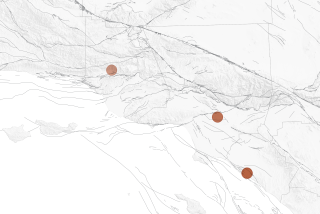Volcanoes : Magma Rises to Fill Crack in Ocean Floor Off Oregon : Hills form where two plates of the Earth’s crust are separating.
- Share via
NEWPORT, Ore. — If it’s not enough these days to have a Hawaiian volcano consuming communities, a Washington state volcano ominously shuddering and belching and a massive Alaskan volcano rumbling from the deep, scientists now have discovered a string of eight or so brand-new baby volcanoes off the coast of Oregon.
In the inky waters almost 300 miles offshore and 1.5 miles underwater, a crack in the Earth’s surface has brought forth fresh eruptions sometime within the last decade.
Where the ocean floor was more or less featureless in 1981, it now is dotted with volcanoes up to 150 feet tall and several thousand feet across.
But only this autumn did anyone find out, and then only with a good bit of luck.
Three scientists here at the Mark O. Hatfield Marine Science Center say their discovery is the first time anyone has come across the active volcanic creation of those famous slow-moving tectonic plates that cover the crust of the planet, forming continents, colliding and creating mountains, rubbing shoulders with each other and triggering earthquakes.
Offshore from Oregon is a zone where two of these plates meet--one the giant sea-floor Pacific Plate and a smaller Northwestern cousin, known as the Juan de Fuca Plate. They are moving in opposite directions, with the Pacific Plate drifting northwest while the Juan de Fuca Plate is creeping southeast at perhaps 6 centimeters per year.
As they pull apart they create what scientists term a “spreading center,” which can be visualized simply as a crack in the ocean floor. Volcanic magma bubbles up from the deep, erupting and adding material to the forming edges of the plates. Because these eruptions occur at a zone where the plates are pulling apart, it is believed that the volcanoes act sort of like mortar, filling the crack. They are not expected to build up and come exploding out of the ocean someday to touch off a new coastal Oregon real estate boom.
“That’s one of the things we know isn’t going to happen,” says William Chadwick, a volcanologist and member of the three-man team of scientists.
The new volcanoes were discovered when sonar maps made in 1989 were compared to maps made of the same region in 1981. Close scrutiny found that sometime in that interval the volcanoes popped up.
Scientists still must figure out how to study what they have discovered. That means designing and building instruments that work for extended periods in the intense pressure of the deep. Right now, there is not a single instrument in place anywhere in the whole area. This will have to wait until summer.
Scientists believe that the hot, mineral-rich eruptions hold clues to both the changing chemical makeup of seawater and ocean temperature.
An altogether different type of undersea volcano is more familiar to non-scientists, and it continues to make news in the Pacific region. That’s Kilauea on the big island of Hawaii. It has been in a state of virtually continuous eruption since January, 1983, destroying nearly 180 homes and adding 300 acres to the land mass of the island (title held by the state of Hawaii).
Kilauea and the whole Hawaiian chain were not formed on the edge of tectonic plates but emerged from a “hot spot” deep inside the Earth. As the giant Pacific Plate drifts over this hot spot, islands one after another pop up.
The next island in the Hawaiian chain is already forming. Its name will be Loihi when it grows another 3,000 feet or so and emerges from the water in a future century.
A similar hot-spot chain of volcanoes exists off the coast of Washington state, although none yet has made it closer than 150 feet to the surface.
Not all of the Pacific Basin’s volcanic news has occurred at sea this autumn. Residents of Washington and Alaska felt their stomachs tighten this November at the stirrings of now-familiar troublemaker volcanoes.
On Nov. 5, an unexpected explosion in the caldera of Mt. St. Helens flung refrigerator-sized boulders half a mile and sent an ash plume toward the stratosphere. The Cascade Volcano Center in Vancouver, Wash., suggested some possible causes. Perhaps it was merely the result of cooling inside the mountain after the giant 1980 eruption, or water seeping into the plumbing of the still-hot volcano and causing a steam explosion. Or . . . .
Experts see a high likelihood of another blast from this deadly explosion-prone volcano in the next 50 to 60 years.
And in Alaska, the 10,197-foot volcano Redoubt, located 110 miles southeast of Anchorage, threw a scare into scientists in early November with a showy display of earthquakes and small blasts that seemed to foreshadow a major eruption.
The mountain last exploded in December, 1989, and has been percolating since.
More to Read
Sign up for Essential California
The most important California stories and recommendations in your inbox every morning.
You may occasionally receive promotional content from the Los Angeles Times.













